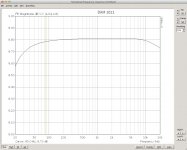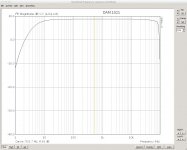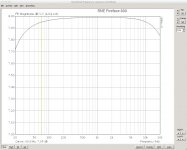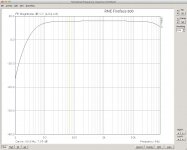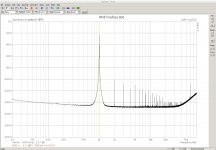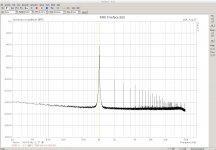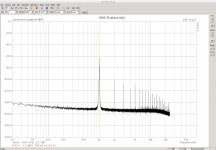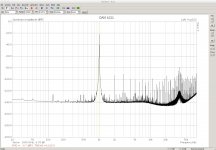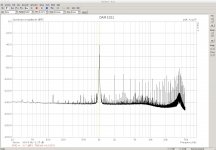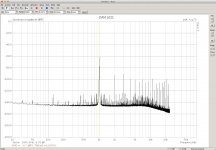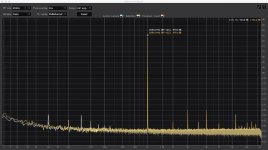SQ
Thanks folks for posting sound quality impressions. Of course, it is a little early for anyone to consider these initial impressions as definitive. My suspicion is that more advanced filter design (especially for the first FIR) and power supply implementation will be required to get the best out of Soren's design. Soren has noted that at this point the filters which are implemented are quite basic and simple.
It might be instructive to feed the DAC 352.8/384 files so as to bypass the 1st filter stage, or to try the excellent HQPlayer software and use its excellent filters to get one up to 352.9/384 and see how that sounds.
Then there is power supply. Anyone who has played around with DAC builds knows how much difference the supply can make.
And finally, output stage design. My guess would be that taking the raw output of the ladder direct into a high input impedance amplifier would give the best idea of what the DAC really sounds like.
Thanks folks for posting sound quality impressions. Of course, it is a little early for anyone to consider these initial impressions as definitive. My suspicion is that more advanced filter design (especially for the first FIR) and power supply implementation will be required to get the best out of Soren's design. Soren has noted that at this point the filters which are implemented are quite basic and simple.
It might be instructive to feed the DAC 352.8/384 files so as to bypass the 1st filter stage, or to try the excellent HQPlayer software and use its excellent filters to get one up to 352.9/384 and see how that sounds.
Then there is power supply. Anyone who has played around with DAC builds knows how much difference the supply can make.
And finally, output stage design. My guess would be that taking the raw output of the ladder direct into a high input impedance amplifier would give the best idea of what the DAC really sounds like.
I got my dam1021 DA in the mail today, and built a minimalistic configuration just with a RCA Spdif input. It worked flawlessly from the beginning, locked into the spdif and played music 
I plan to use it in a Studioenvironment as an DA Loopbackconverter and tested it against a RME Fireface UFX DA.
Since I could compare both converters (Volume adjusted to a 10th of a Db) in an AB test I know now ,for me at least, that the DAM1021 is closer to the source than the UFX. It simply sounds more relaxed and natural than the UFX, which isn't real highend but still considered a good converter.
That is really good news for me!
The only thing that is a bit problematic is that the dam1021 is kind of low on output voltage on the balanced outs, compared to other studio converters at least, but that is workable, you should not torture your precious analogue equipment with high levels anyway.
Thanks for this project, it seems to be a real winner.
Tobias
I plan to use it in a Studioenvironment as an DA Loopbackconverter and tested it against a RME Fireface UFX DA.
Since I could compare both converters (Volume adjusted to a 10th of a Db) in an AB test I know now ,for me at least, that the DAM1021 is closer to the source than the UFX. It simply sounds more relaxed and natural than the UFX, which isn't real highend but still considered a good converter.
That is really good news for me!
The only thing that is a bit problematic is that the dam1021 is kind of low on output voltage on the balanced outs, compared to other studio converters at least, but that is workable, you should not torture your precious analogue equipment with high levels anyway.
Thanks for this project, it seems to be a real winner.
Tobias
I have a suitable transformer 'in bound' to compare AC / DC performance. I'm very curious to see. While I understand and accept the logic that the onboard PS's are more than adequate, running with the S03 DC 12V and a Reflektor-D powering the ISO 3.3 - my impressions are much stronger than yours. It's very much in focus, dynamic and for the most part neutral.
Sounds promising.
As suspectable the measures of the frequency responce of the DAM 1021 look very well. To compare I also posted the corresponding diagramms for the RME Fireface 800, with which I also measured.I guess this part can be checked pretty easily.
The first diagramm shows the 20-20kHz range in detail and the next the 1-96kHz range.
Attachments
As suspectable the measures of the frequency responce of the DAM 1021 look very well. To compare I also posted the corresponding diagramms for the RME Fireface 800, with which I also measured.
The first diagramm shows the 20-20kHz range in detail and the next the 1-96kHz range.
The dam1021 is actually DC coupled without any low frequency cutoff, so the low frequency response is due to your measurement equipment....
I will probably add a digital lowpass filter in next release of the filter sets.
Source -
Synology NAS WiFi->Lan repeater ethernet out via MeiCord Opal patch cable (as recommended by Klaus ‘Soundcheck’)->Squeezebox Touch w. EDO applet and BTWS psu, USB out via modded USB cable->Amanero I2S->DAM1021-01 onboard *xlr out via Artisan Silver cable->
1. headfi system -
Questyle CMA800R solid state headphone amp via Aphrodite Cu29 Zeus pure copper cable->LCD-3
2. headfi system -
Stax SR-006t-> Sennheiser HE60 electrostats
* alternatively rca out via Nordost Blue Heaven->
Note that I’m very familiar with the sound and performance of these systems as I have been using them both quite intensively.
So no speakers?
//
Here the frequency spectra at sample frequencies 48kHz, 96kHz, 192kHz.
There is no peak around 50Hz from the power line as there was in an other post. The DAM is powered with a trafo AC and is not shilded in a case.
Again the diagrams for the RME Fireface are added to compare.
Although the RME measurements look better I can't say I like its sound better.
There is no peak around 50Hz from the power line as there was in an other post. The DAM is powered with a trafo AC and is not shilded in a case.
Again the diagrams for the RME Fireface are added to compare.
Although the RME measurements look better I can't say I like its sound better.
Attachments
Hi Tobias!
Greets:
Tyimo
What and how did you connected?I got my dam1021 DA in the mail today, and built a minimalistic configuration just with a RCA Spdif input.
Greets:
Tyimo
I am not sure.Your measurement systems sampling freq should not be the same as the DUTs. Is it?
//
When I changed the Fs seting of the ARTA software, the frequency of the Fireface (acording its own contol panel) kept uncanged at 192kHz.
The DAM 1021 got its digital signal from the digital out of the Fireface, so with the same rate as the Fireface runs.
I will later connect the DAM by USB and see if I can choose the sample rates independently.
Last edited:
Thanks folks for posting sound quality impressions. Of course, it is a little early for anyone to consider these initial impressions as definitive. My suspicion is that more advanced filter design (especially for the first FIR) and power supply implementation will be required to get the best out of Soren's design. Soren has noted that at this point the filters which are implemented are quite basic and simple.
It might be instructive to feed the DAC 352.8/384 files so as to bypass the 1st filter stage, or to try the excellent HQPlayer software and use its excellent filters to get one up to 352.9/384 and see how that sounds.
Then there is power supply. Anyone who has played around with DAC builds knows how much difference the supply can make.
And finally, output stage design. My guess would be that taking the raw output of the ladder direct into a high input impedance amplifier would give the best idea of what the DAC really sounds like.
+1 ! That's the way I plan to use it when I order mine.
--Really great filters in an FPGA are tough and the Poly-sinc filters of HQ Player are among the very best;
--No problem providing it with multiple, isolated rails of very clean DC power;
--Will skip the opamps and use the raw output into a discrete stage.
Can someone remind me of why the max input rate is 384Khz? I'd be glad to feed it 768Khz from HQ Player.
And can anyone (Soren) confirm when fed 352/384 the filters in the FPGA are then off entirely? Or is there a setting to turn them off?
And I am certainly looking forward to understanding how DSD will be handled.
While this lovely board includes a lot and can be used in many ways--from almost complete plug'n'play to minimally--my interest in it is for the sign-magnitude R2R ladders, and its isolation and clocking. I'll bring the clean power, the high-rate bits, and the output stage. By doing that, the DAC really should not have any sound of its own.
That said, I am looking forward to the future release of the filter design tools (I think Soren said TFilter s/w ail be used) and instructions for loading coefficients.
For a while I think people need to be careful about reviews of the SQ of the board since so much depends upon the way you use it.
@ those with a RS232-USB adapter that works with the DAM1021: could you please post brand and model, as mine seems not o wake the DAC from its power saving mode.
I'm using an Aten UC-232a. It something that I've had for years but they appear to still be available.
USB-to-Serial Converter - UC232A, ATEN USB Converters
The loopback measurements of the RME are already among the diagramms, the second half of them.zfe - do a loopback measurement of your RME an post it please?
//
Here the frequency spectra at sample frequencies 48kHz, 96kHz, 192kHz.
There is no peak around 50Hz from the power line as there was in an other post. The DAM is powered with a trafo AC and is not shilded in a case.
Again the diagrams for the RME Fireface are added to compare.
Although the RME measurements look better I can't say I like its sound better.
Attached is a -60dB frequency spectra at 44.1kHz.
Faber Acoustical Signal Suite -> TC Electronic Konnekt 8 SDPIF out -> DAM1021 -> Konnekt 8 (Mic inputs with pad engaged and set to minimum) -> Isotope RX. Sampling rates are both the same.
Attachments
Dear Superdad,
Can you please share what you are doing with your board, that will be of great help to all of us, you know your way around digital stuff and that will help a lot of people avoid the snake oil salesmen.
Sorry, but I have not even ordered mine yet! Besides, I am actually a novice, but one with a really smart close friend, the well known engineer John Swenson.
As for snake oil salesmen, I don't see too many of those here on diyAudio (though this is not my regular place to hand out; I am mainly over on ComputerAudiophile.com).
I do think Soren's board has tremendous potential--even for those using all its built-in features (PS, filters, output stage, etc.). But getting the filters right is key, so it seems likely that he will continue to refine those and people can just load them in.
Early days…
- Home
- Vendor's Bazaar
- Reference DAC Module - Discrete R-2R Sign Magnitude 24 bit 384 KHz
